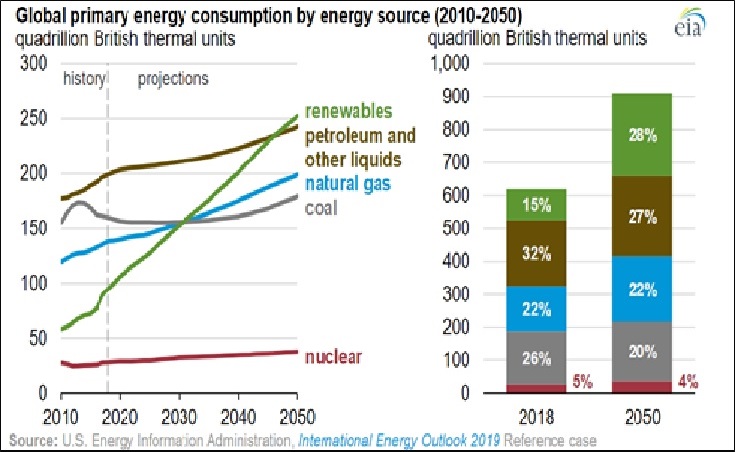What comes to mind when you hear someone mention energy investments? Most likely and especially in this state, thoughts turn to oil and gas. Investments might include stock in companies like ExxonMobil or Valero, maybe an allocation to an MLP strategy, or even a private equity investment in oil production from Texas’ Permian basin. No matter the flavor, most people think oil when they think of energy, and rightfully so as oil and natural gas make up almost 70% of U.S. energy supply.
Thoughts of cyclicality, volatility and lackluster sentiment also serve as common companions to oil and gas related investments. Having managed energy industry equities for more than 20 years, we are intimately familiar with these influences and the biases and misconceptions that are forged by them. But today, the world of energy is transforming; some of the things we think we know about energy and energy investments no longer apply. In this article, we seek to challenge some of the biases and misconceptions about energy investing that left unchecked might otherwise cause investors to miss out on what will likely be one of the most transcendent investment opportunities in the coming decade.
What is Energy?
Energy has been called the “lifeblood of the economy” and “industrial oxygen.” No wonder given that all economic activity depends on energy. Our investment assumptions about economic growth are predicated on a corresponding growth in energy demand, especially in emerging economies where economic expansion is the key to higher standards of living.
For decades, fossil fuels have been the singular provider of energy to run the global economy – whether coal or natural gas to create electricity or oil, gasoline, or diesel to provide transportation via cars, buses, trucks, ships, and airplanes. But increasingly, energy is becoming something more. Around the world, electricity demand is driving energy demand growth as the world moves towards the “electrification of all things.” At the same time, concerns over fossil fuel availability and climate change are driving a massive deployment of green, renewable sources of power generation. Solar, wind, nuclear and other renewable energy sources are becoming a meaningful part of our energy supply and are poised for remarkable growth. The International Energy Agency (IEA) expects renewable energy to double in the next decade and surpass oil, natural gas, and coal by 2050.

The Binary Fallacy
The apt-named binary fallacy – that something is either black or white or that it’s either one way or the other – is a common misconception prevalent in the context of energy investment. Many, especially those with a history in the oil and gas industry, are dismissive of renewable energy sources and the role those sources will play going forward. To them, windmills have been around for centuries, are uneconomic, intermittent and can never replace fossil fuels. Others have an opposite perspective. They see fossil fuels as old and dirty, convinced that we will leave oil behind in coming years and live in a world powered exclusively by clean, renewable energy. “We didn’t leave the Stone Age because we ran out of rocks,” they say. As a result, the binary view limits investment considerations.
While there is some truth to both perspectives, the future of energy will most certainly not be one or the other. Instead, energy’s future will be characterized by an “all energy” approach, with a continued dominant role for fossil fuels coupled with a rapid expansion of clean, renewable energy. As the graphic above suggests the only way to meet global energy demand in the future will be an increase in energy production from all sources, with renewables representing the most prolific growth story.
We are nowhere near leaving fossil fuels behind. Today, fossil fuels account for 80% of the world’s energy production. Even with lofty predictions for growth in renewables, the IEA estimates that fossil fuels will continue to account for 70% of global energy in 2050. Also consider that emissions from newly constructed coal plants in China last year produced more carbon emissions than all the retired coal plants worldwide and that electric vehicles, despite growing sales, still represent barely 1% of the global automobile fleet. But the world’s continued reliance on fossil fuels should not be interpreted as a limit on the growth in clean, renewable energy deployment.
Clean, renewable energy is the stealth growth story of the next decade
A list of exhibits evidencing the massive expansion of clean energy and the related investment opportunities is simply too long for this article. But there are few noteworthy points to consider. Concerns over climate change are shaping global energy policy in a profound way. Whether it is the Paris Climate Accord, statements from emerging economies like China and India, or U.S. infrastructure plans, the world is moving rapidly towards lower carbon emissions and more clean energy.
Unlike fossil fuels, demand for clean energy comes from two sources, not one. The first is the insatiable demand for new power generation in the developing world. In the next decade, power generation in areas like India, Southeast Asia and Africa is set to expand by more than 50% of current levels, and most of that growth will come from renewable sources, primarily solar and wind. Demand for renewable energy also comes from the transition away from fossil fuels in the developed economies. Renewable power generation is expected to grow 4x that of new power generation capacity in the U.S. and 10x capacity additions in Europe.
Lastly, a step change in the cost of renewable energy represents another key component of the clean energy story. In years past, energy from solar, wind and other renewables relied on government mandate or subsidy. While those factors remain relevant, the cost of new solar powered generation is becoming competitive with fossil fuels in many parts of the world. The declining cost of lithium batteries is having a similar effect in the world of electric vehicles.
Looking back, it’s easy to compile a list of the truly transformative technologies that led to what we now consider historic investment opportunities – the semiconductor, the personal computer, the smart phone and online retail sales are all examples of technologies that forever changed the way we do things. The companies at the forefront of these evolutions would make any list of the most successful investments of recent times.
The emerging transformation in the way the world uses and sources energy presents a similar dynamic. Even a cursory review of the outlook for growth in renewable energy and the underlying economics of the companies involved reveals a compelling investment paradigm that remains just under the surface.
A primary tenet of behavioral finance and successful investing requires us to challenge exiting biases and identify misconceptions. Looking past preconceptions, energy remains essential to economic expansion around the world, lifting millions out of poverty and addressing concerns over the world’s climate. As the world forever changes the way we source and use energy, the investment implications are simply too profound to ignore.
About L. Farrell Crane, Jr.
 L. Farrell Crane, Jr. serves as President and Senior Portfolio Manager at Energy Opportunities Capital Management, LLC (EOCM), a SEC registered investment adviser specializing in equity investments in both the traditional and renewable energy industries. EOCM is a subsidiary of Orleans Capital Management, which manages fixed and broad market equity. Crane has over 20 years of investment management experience managing both fixed income and equity allocations and has served as the portfolio manager of the Energy Opportunities strategies since inception in 2000. He also serves as Director of Research at EOCM’s affiliate, Orleans Capital Management. Before joining EOCM, Crane spent 13 years as a corporate lawyer, managing financial restructurings of both publicly and privately held institutions. He holds a bachelor’s degree in Economics from Austin College and a Juris Doctorate from the University of Texas.
L. Farrell Crane, Jr. serves as President and Senior Portfolio Manager at Energy Opportunities Capital Management, LLC (EOCM), a SEC registered investment adviser specializing in equity investments in both the traditional and renewable energy industries. EOCM is a subsidiary of Orleans Capital Management, which manages fixed and broad market equity. Crane has over 20 years of investment management experience managing both fixed income and equity allocations and has served as the portfolio manager of the Energy Opportunities strategies since inception in 2000. He also serves as Director of Research at EOCM’s affiliate, Orleans Capital Management. Before joining EOCM, Crane spent 13 years as a corporate lawyer, managing financial restructurings of both publicly and privately held institutions. He holds a bachelor’s degree in Economics from Austin College and a Juris Doctorate from the University of Texas.
Energy Opportunities Capital Management, a subsidiary of Orleans Capital Management, an Associate member of TEXPERS. The views expressed herein do not constitute research, investment advice or trade recommendations and do not necessarily represent the views of Energy Opportunities Capital Management, Orleans Capital Management, nor TEXPERS. Views are subject to change over time. Follow TEXPERS on Facebook, Twitter, and LinkedIn for the latest news about the public pension industry in Texas.


